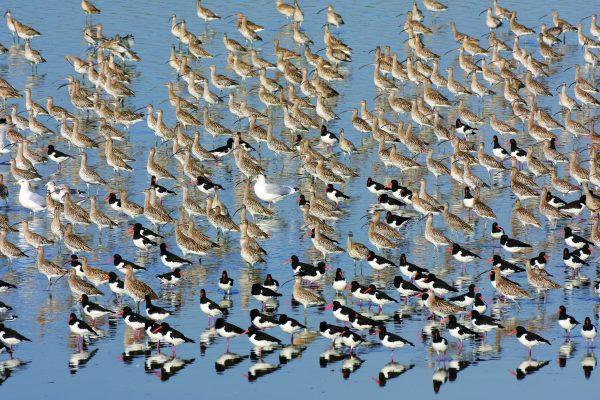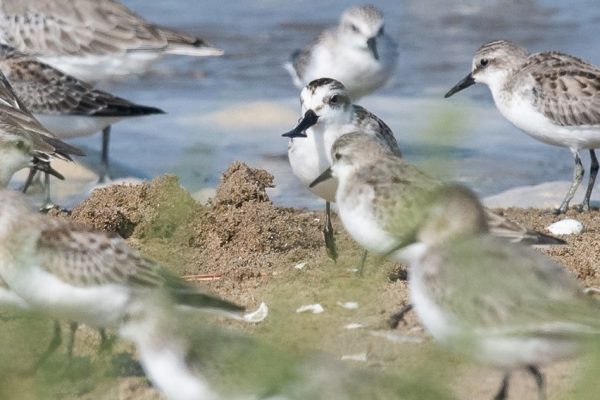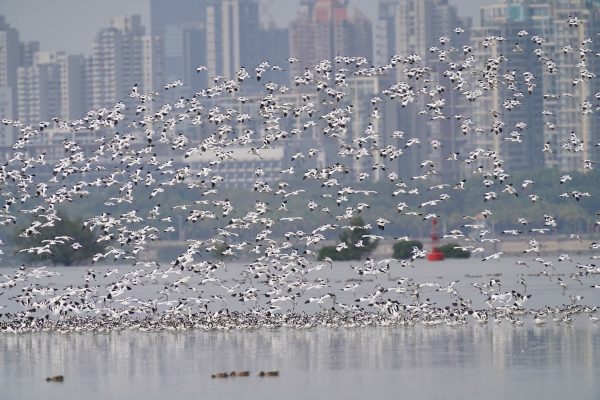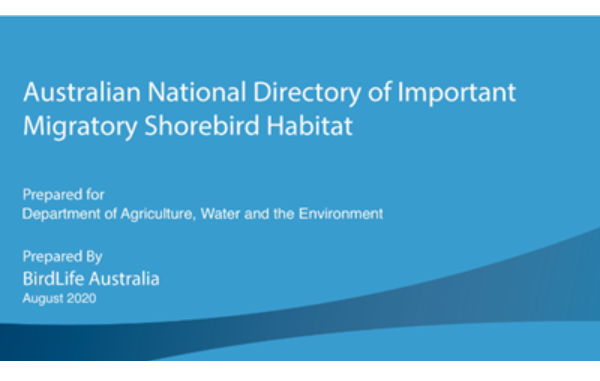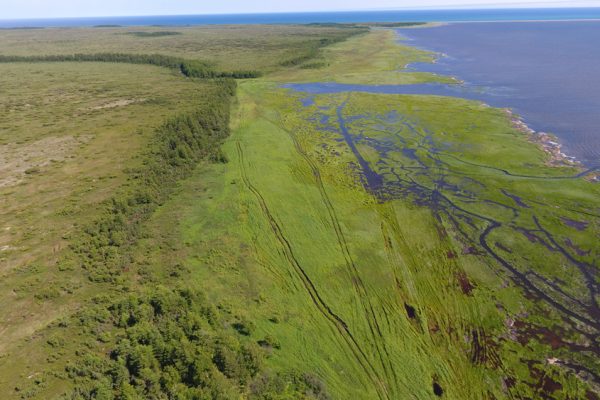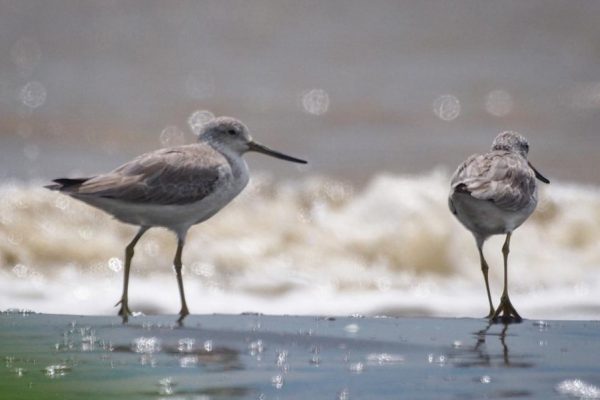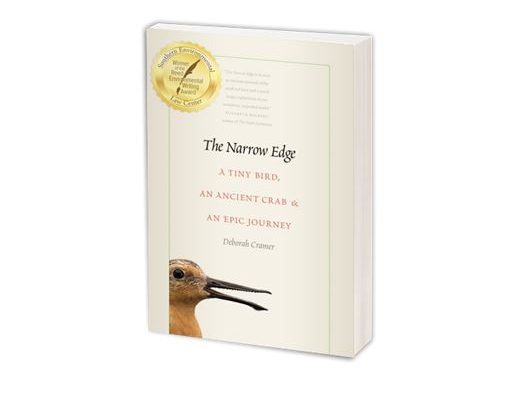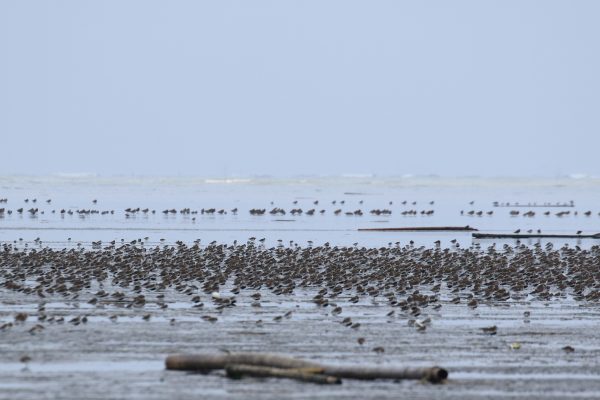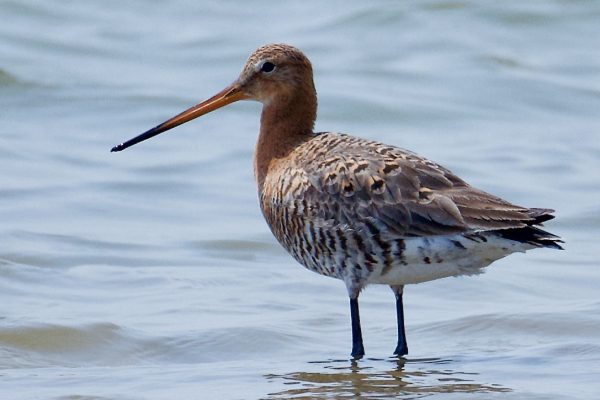-
“Getbol, Korean Tidal Flats” inscribed on UNESCO World Heritage List
On 26th July, 2021, the 44th Session of the World Heritage Committee endorsed the inscription of the Republic of Korea’s tidal flats on the UNESCO World Natural Heritage List, marking an enormous step forward to secure the critical habitats of the Yellow Sea for millions of migratory waterbirds that depend on this area as a vital stopover on their migratory journeys from as far away as Australia and New Zealand to breeding grounds in Arctic Russia and Alaska. Great Knot and Bar-tailed Godwit ©WH Promotion Team of Korean Tidal Flat The inscription of the “Getbol”, the Korean name for tidal flats, was announced during the World Heritage Committee meeting held in Fuzhou City, China and follows over 10 years of intensive preparation by the Korean authorities. The four sites included in the Phase I inscription of Seocheon Getbol, Gochang Getbol, Shinan Getbol and Boseong-Suncheon Getbol, collectively cover over 128,000 hectares of coastal wetlands in the Southwestern part of the country. Additional areas will be added as part of a Phase II nomination. The shallow waters in the Yellow Sea region jointly shared by China, DPR Korea and Ro Korea hold some of the largest and most spectacular intertidal wetlands in the world. These sites support exceptionally rich biodiversity, but are best known for some of the largest congregations of migratory waterbirds in eastern Asia, many of which are globally threatened by habitat loss along their migratory pathways, collectively known as the East Asian – Australasian Flyway. Up to 100,000 shorebirds use the mudflats around Yubu island in the Seocheon Getbol during migration, including the Critically Endangered Spoon-billed Sandpiper and the Endangered Far Eastern Curlew. Other species, such as Vulnerable Saunders’s Gull and Endangered Black-faced Spoonbill stay to nest in the coastal wetlands of the Yellow Sea. “The inscription of the Getbol in the World Heritage List will mark a great shift of paradigm for Getbol tidal flats protection and management policy, as well as the increasing public awareness. The Getbol's World Heritage inscription means that the tidal flats managed by locals become a shared global property for the next generation of all humanity. All stakeholders involved with the Getbol will make the best effort to complete its Phase II extension and even further in the future.’’ said Dr. Kyong-O Moon, the Secretary-General of the Korea Getbol World Heritage Promotion Team. “The Korean Getbol inscription complements the “The Migratory Bird Sanctuaries along the Coast of the Yellow Sea-Bohai Gulf of China (Phase I)” World Heritage Site listed in 2019. It will strengthen international collaboration, particularly in the vision of transboundary joint efforts with China and DPR Korea, to conserve the wetlands of the Yellow Sea region, the irreplaceable migration hub for migratory waterbirds shared by the 22 countries in the Flyway,” said Mr. Doug Watkins, Chief Executive of EAAFP, an international partnership to conserve migratory waterbirds along the Flyway. “The UNESCO World Heritage Convention offers an exceptionally powerful framework to secure the future of globally important biodiversity. The BirdLife International Partnership look forward to working closely with the EAAFP and IUCN to secure the same status for the remaining such areas of the Yellow Sea, and to support the authorities to ensure all receive the best possible management for birds and people.’’ said Dr. Ding Li Yong, BirdLife International (Asia Division) Flyways Coordinator. Decision paper (download at: https://whc.unesco.org/en/sessions/44COM/documents/#amendment ) Far Eastern Curlew and others © WH Promotion Team of Korean Tidal Flat Black-faced Spoonbill © WH Promotion Team of Korean Tidal Flat Spoon-billed Sandpiper ©WH Promotion Team of Korean Tidal Flat Hooded Cranes in Suncheon Bay ©WH Promotion Team of Korean Tidal Flat Click [here] for the UNESCO WHC official announcement. Click [here] for the local news media archive. Local news reports: Korean Version: 한국의 갯벌’, 유네스코 세계유산 등재 2021년 7월 26일 ‘한국의 갯벌’은 제 44차 세계유산위원회(WHC)에서 유네스코 세계자연유산으로 등재 됐다. 이 지역은 뉴질랜드· 호주부터 러시아 알래스카까지 이동하는 수백만 마리 철새의 황해 상 중간기착지로서 세계적으로 중요하고 의미있는 서식지 보전에 매우 큰 발걸음이 되었다. 중국 푸저우에서 열린 제44차 세계유산위원회는 한국의 갯벌을 세계자연유산 등재로 최종 확정했다. 이는 한국이 10년 간 준비한 작업의 성과라고 볼 수 있다. 1단계 세계자연유산 대상지로는 서천갯벌, 고창갯벌, 신안갯벌, 보성-순천갯벌, 4곳으로 총 12만8000ha가 넘는 서남해해안 습지이다. 2단계 추진과정에서 추가지역들이 포함될 예정이다. 중국과 남북한이 공유하고 있는 황해지역은 세계에서 가장 크고 장관을 이루는 조간대 습지다. 이 지역은 생물다양성이 매우 풍부하고, 최대 규모 집단인 동아시아 지역의 이동성 물새 서식지 감소로 인해 전 세계적으로 가장 위협을 받는 지역이며, 동아시아-대양주 철새이동경로 상에 있다. 멸종위기에 처한 넓적부리도요, 알락꼬리마도요를 포함 한 최대 10만 마리까지 이동 기간동안 유부도 주변(서천 갯벌)을 이용한다. 또한 취약종인 검은머리갈매기와 멸종위기종 저어새와 같은 다른 종은 황해 연안 습지에 둥지를 튼다. 한국 갯벌 세계유산 등재추진단 문경오 사무국장은 “한국의 갯벌 유네스코 세계유산 등재는 갯벌 보호 및 관리 정책의 패러다임을 전환하는 계기가 될 것 이며, 대중 인식 증진에도 큰 기여를 할 것이다.” 이어서 “한국의 갯벌 유네스코 세계유산 등재는 지역 주민이 관리하는 갯벌에서 더 나아가 전 지구적으로 공유하는 자산으로 모든 인류를 포함하여 다음 세대에 넘겨줄 자산이 된다는 의미다. 갯벌과 관련된 모든 이해관계자들은 2단계(Phase II) 상향과 향후 더 확장할 수 있도록 최선을 다할 것이다” 라고 말했다. 국제철새보호 기구 동아시아-대양주 철새이동경로 파트너십(EAAFP) 사무국 더그 와킨스(Doug Watkins) 대표는 “한국 갯벌 등재는 2019년 세계유산에 등재된 ‘중국 황하이 연안-보하이 만의 철새 보호구역(1단계)’을 보완한다. 특히 국경을 넘어 공동 비전인 황해 보전을 위해 중국과 남북한의 국제 협력과 황해 지역의 습지를 보전하여 대처할 수 없는 22개국이 함께 공유하는 철새이동경로 보전 노력이 강화 될 것” 이라고 말했다. 딩리 용(Ding Li Yong) 버드라이프 인터내셔널(BirdLife International) 아시아 지부 이동경로 코디네이터는 “유네스코 세계유산협약은 세계적으로 중요한 생물다양성의 미래를 보장하기 위한 매우 강력한 프레임워크를 제공한다. 버드라이프는 EAAFP및 유네스코 심사 자문기구인 세계자연보전연맹(IUCN) 과 긴밀히 협력하여 황해의 나머지 지역에도 동일하게 보전을 확보하여 당국이 조류와 인류을 위한 최상의 관리를 받을 수 있도록 지원하기를 기대한다” 라고 말했다.
Continue reading -
Getting Getbol (intertidal mudflats) of the Republic of Korea into World Natural Heritage Site inscription
Spoon-billed Sandpiper in Yubudo © Henrik Thorlund The West/Yellow Sea, lies at the heart of the East Asian-Australasian Flyway, a migratory route for 50 million migratory waterbirds traverse on an annual basis which stretches from Russia Far East and Alaska, U.S.A. south to Australia and New Zealand covering 22 countries. This region is surrounded by three countries: The People’s Republic of China, the Democratic People’s Republic of Korea (DPR Korea) and the Republic of Korea (RO Korea). The wetland habitats in this region, especially the intertidal mudflat in this area serve as fuelling, staging stations for two million shorebirds, or 40% of total birds in the Flyway, annually. However, the intertidal mudflat in this region has shrunk by over 65% in past decades, but recent studies in countries outside the Yellow Sea region showing rapid declines of migratory shorebirds strongly related to the loss of the birds’ habitats in the West/Yellow Sea. This illustrates the sites in different countries along the Flyway are highly interconnected due to the migratory waterbirds, and it is crucial to protect, as it is one of the world’s most important migratory bottlenecks for watebirds. The Government of the Republic of Korea has nominated 4 sites of intertidal mudflats, or “Getbol” in Korean, on the country’s southwestern coast of the Yellow/West Sea as the candidate of UNESCO’s World Heritage listing. This group of four sites included in the Phase I nomination are Seocheon Getbol (EAAF101), Gochang Getbol, Shinan Getbol (EAAF146) and Boseong-Suncheon Getbol (EAAF079), covering over 128,000 ha (or 1280 km2) of wetlands. Apart from its spectacular geological processes, these areas are rich in biodiversity, with 2,169 invertebrate species, 857 macrobenthos, 152 marine macroalgae, 47 endemic and 5 endangered marine invertebrate species recorded. The richly diverse benthic community supports a huge number of migratory waterbirds. In addition, the endangered Narrow-ridged Finless Porpoise is often found in the waters within the nominated sites. Hooded Crane in Suncehon Bay © Suncheon City Office Bird surveys have revealed that these sites supported 102 waterbird species and some 34 species with internationally important numbers. The sites were crucial for 15 globally threatened waterbird species including Spoon-billed Sandpiper (CR), Far Eastern Curlew (EN), Nordmann’s Greenshank (EN), Great Knot (EN), Black-faced Spoonbill (EN), Hooded Crane (VU), Saunders’s Gull (VU), Chinese Egret (VU) Swan Goose (VU), Relict Gull (VU), Horned Grebe (VU), White-naped Crane (VU) and Common Pochard (VU). The nomination would also secure the reintroduced population of Oriental Stork (EN). Legflag observations and satellite tracking data furthered confirmed the nominated sites interlinked with other countries in the Flyway. Because of such ecological connectivity of the migratory waterbirds along the Flyway, the World Heritage inscription is not just a matter to the Republic of Korea, as it contributes to assuring that the critical staging area for migratory waterbirds in the Flyway is secured. It is essential to safeguard the integrity of Yellow/West Sea intertidal flat, together with the on-going designation of World Heritage Sites along China coast of the Yellow Sea and potentially with the habitats along DPR Korea at a future date. The future of millions of migratory waterbirds now lay on the hands of the World Heritage Committee to agree on the “Outstanding Universal Value” of this Getbol nomination. The result announcement for this nomination will be made at the upcoming annual meeting of the World Heritage Committee in China in July 2021. Watch the video about the Getbol: Click [here] or the image to enjoy the photo book: Suncheon Bay © Suncheon City Government
Continue reading -
20-Year Population Trends of Wintering Waterbirds in Deep Bay, South China
Along the East Asian-Australasian flyway (EAAF), waterbirds are threatened by a wide range of environmental and anthropogenic factors. Habitat transformation along the coast of China, especially in the Yellow…
Continue reading -
EAAF Shorebird Tracking Group 1st Webinar
The EAAF Shorebird Tracking Group, established in 2021 following the 1st East Asian-Australasian Flyway Shorebird Science Meeting in 2020, held the first webinar on 13th…
Continue reading -
Australia published National Directory of Important Migratory Shorebird Habitat
A National Directory of Important Migratory Shorebird Habitat ('Directory') was newly published by BirdLife Australia and supported by the Australian Government. The Directory identifies, and guides investment into the protection and restoration of, important migratory shorebird habitat around Australia. It builds community awareness and Indigenous knowledge, helps achieve the goals of the Australian Government’s Wildlife Conservation Plan for Migratory Shorebirds and contributes to the implementation of Australia’s international obligations to the conservation and management of migratory shorebirds. It is based on thousands of field surveys by volunteers and experts, millions of bird sightings and uses rigorous methodology to identify key sites, thus providing useful and objective guidance. Habitat is key: Populations of many species of migratory shorebirds have undergone substantial decline over recent and extended periods of time. As an example, numbers of Far Eastern Curlew (Numenius madagascariensis) have declined by more than 80% over the course of by now four decades. Halting this decline and reversing the current trend is without alternative if threatened species are to avoid extinction and continue to contribute as an integral component of Australia nation’s biodiversity to the functioning of Australia’s ecosystems. Actions and processes threatening migratory shorebird habitat have to be effectively recognized and mitigated. In order to achieve this, decision-makers and stakeholders around Australia need to be able to easily access information on the importance of sites for migratory shorebirds. The directory provides this crucial link which was not previously been available. The Directory also provides a starting point for a more comprehensive assessment of the current state of the habitat listed, a prioritization of sites according to current or future threats experienced and more targeted conservation action. This directly addresses and supports some of the priority actions in the Australian Government’s Wildlife Conservation Plan for Migratory Shorebirds across the main objectives: protection of important habitat, anthropogenic threat minimization or elimination and knowledge gap identification. A number of high priority projects are already in the process of being implemented, the Directory makes those more effective and targeted. The Directory is an important step towards effective migratory shorebird habitat protection around Australia. Revision of conservation and management plans for many sites may be necessary to reflect their importance. Specific site action plans detailing conservation measures to be taken for migratory shorebirds at a single site can be developed as a follow-up action. The directory thus also represents a key resource underpinning further conservation measures under Australia’s Conservation Action Plan for Migratory Shorebirds and other frameworks. The Australian Government, which provided gratefully acknowledged funding for this scientific project delivered by BirdLife Australia, has approved of the Directory after consultations with its Committees and all Australian States and Territories. The document has been officially launched on 21 April 2021. It is available for download in *.pdf format in its latest version: National Directory of Important Migratory Shorebird Habitat Download the complete Directory (one file or, due to file size, chapters separately) from the download folder. It is advised to always read the Introduction and Discussion alongside the chapter you need. Overview of chapters: Introduction and Methods Chapter 1 - External Territories Chapter 2 - New South Wales and Australian Capital Territory Chapter 3 - Northern Territory Chapter 4 - Queensland Chapter 5 - South Australia Chapter 6 - Tasmania Chapter 7 - Victoria Chapter 8 - Western Australia Chapter 9 - Species accounts (listing of sites by species, not by site) Discussion and Appendices Due to the large size of the document (1287 pages printed), there are no printed copies are available – please arrange for own printing and binding if desired. If you have feedback on the Directory process or the Directory itself, or you have additional data to contribute to a potential future revision, please write to directory.feedback@birdlife.org.au If you have other questions regarding the Directory, please contact shorebirds@birdlife.org.au For data extractions from BirdLife Australia’s shorebird data holdings, see the Data Extractions section. Repost from BirdLife Australia news article: https://birdlife.org.au/projects/shorebirds/national-directory-ms-habitat (Released on: 21st April, 2021) Know more about Flyway Network Sites in Australia: www.eaaflyway.net/australia/
Continue reading -
Studying the breeding ecology of Endangered Nordmann’s Greenshank and Common Redshank in Schaste Bay, Russian Far East for enacting efficient conservation planning
In 2020, a small research team from Russia studied the breeding ecology of Endangered Nordmann’s Greenshank (Tringa guttifer) and ubiquitous Common Redshank (Tringa totanus ussuriensis) in Schaste Bay, Khabarovsk…
Continue reading -
The Critical Non-breeding Habitat of Nordmann’s Greenshank at Pantai Cemara, Jambi
Pantai Cemara, located in Jambi Province, Sumatra, Indonesia, is known as one…
Continue reading -
New book “THE NARROW EDGE”, by Deborah Cramer, telling the story of Red Knots
Introduction of the book The Narrow Edge Each year tiny sandpipers—Red Knots—undertake a near miraculous 19,000 mile journey from one end of the…
Continue reading -
The southern Jiangsu coast is an important ‘dressing room’ for Spoon-billed Sandpipers and Nordmann’s Greenshanks
If you are lucky to see the Critically Endangered Spoon-billed Sandpipers or Endangered Nordmann’s Greenshanks on the southern Jiangsu coast, they are probably busy gobbling up seafood on the…
Continue reading -
A hitherto undescribed population of Black-tailed Godwits in the EAAF
Occurring across Eurasia, the black-tailed godwit has three recognized subspecies, from east to west melanuroides, limosa, and islandica, respectively. With the smallest body size, melanuroides has been considered the…
Continue reading

